Global Herbal Medicine Market: By Medicinal Plant, By Intervention, By Product Form, By Source Outlook, By Distribution Channel, By Application, By Region & Segmental Insights Trends and Forecast, 2024 – 2034
- Industry: Healthcare
- Report ID: TNR-110-1149
- Number of Pages: 420
- Table/Charts : Yes
- June, 2024
- Base Year : 2024
- No. of Companies : 10+
- No. of Countries : 29
- Views : 10277
- Covid Impact Covered: Yes
- War Impact Covered: Yes
- Formats : PDF, Excel, PPT
Herbal medicine, also known as botanical medicine or phytotherapy, involves using plant-based substances to treat and prevent various health conditions. This practice harnesses the therapeutic properties of roots, leaves, flowers, seeds, and other parts of plants. Herbal medicine has been integral to traditional healthcare systems worldwide for centuries, forming the foundation of practices such as Traditional Chinese Medicine (TCM) and Ayurveda. Modern herbal medicine combines these ancient traditions with contemporary scientific research to validate the efficacy and safety of plant-based treatments.
Herbal remedies are available in numerous forms, including teas, tinctures, capsules, and topical applications. They are often sought for their natural origins, minimal side effects, and holistic approach to health, which aims to support the body’s innate healing processes. With growing consumer interest in natural and sustainable health solutions, herbal medicine continues to gain popularity and recognition as a viable complement to conventional medical treatments.
The demand for herbal medicine is driven by a confluence of health, cultural, and market trends. Growing consumer awareness about the side effects of synthetic pharmaceuticals has spurred a shift towards natural and holistic health solutions, enhancing the appeal of herbal remedies. The rise in chronic health conditions, such as arthritis, diabetes, and cardiovascular diseases, prompts individuals to seek out herbal alternatives known for their long-term benefits and minimal side effects. Cultural and traditional practices, especially in regions with rich herbal medicine histories like Asia and Africa, continue to sustain and boost demand.
Additionally, scientific research validating the efficacy of various herbal treatments has increased consumer trust. The expansion of e-commerce and digital marketing also facilitates broader access to and awareness of herbal products. Combined with the increasing popularity of wellness trends and organic lifestyles, these factors collectively drive robust growth in the herbal medicine market.
In terms of revenue, the global herbal medicine market was worth US$ 72.5 Bn in 2023, anticipated to witness CAGR of 22.2% during 2024 – 2034.

Global Herbal medicine Market Dynamics
Increasing Health Consciousness: Growing awareness about the adverse effects of synthetic drugs is pushing consumers towards natural and holistic healthcare solutions, boosting demand for herbal medicines. Strong cultural ties and traditional uses of herbal medicine in regions like Asia-Pacific and Africa contribute to sustained demand, as these remedies are deeply ingrained in local healthcare practices.
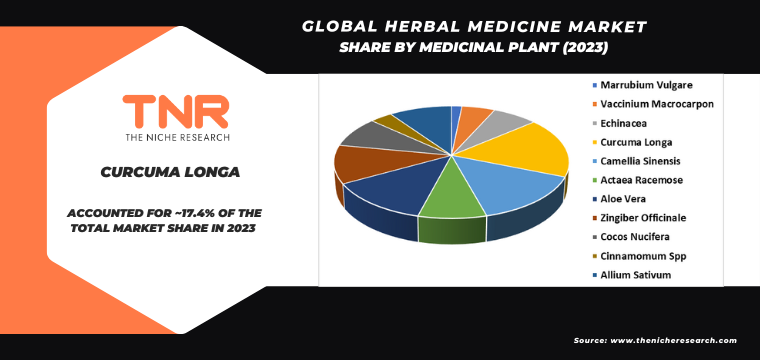
Rising Prevalence of Chronic Diseases: The surge in chronic diseases such as diabetes, arthritis, and cardiovascular issues prompts a greater reliance on herbal remedies known for their long-term health benefits and fewer side effects. The aging global population seeks gentle and natural treatments for age-related ailments, further propelling the herbal medicine market.
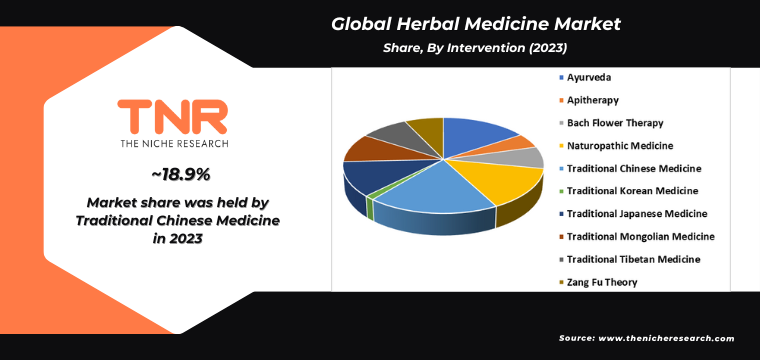
Product Innovation and Diversity: Continuous innovation in product formulations and delivery methods, such as teas, capsules, extracts, and topical applications, cater to varied consumer preferences, enhancing market appeal. Rising disposable incomes, particularly in emerging economies, enable more consumers to afford premium herbal products, contributing to market growth.
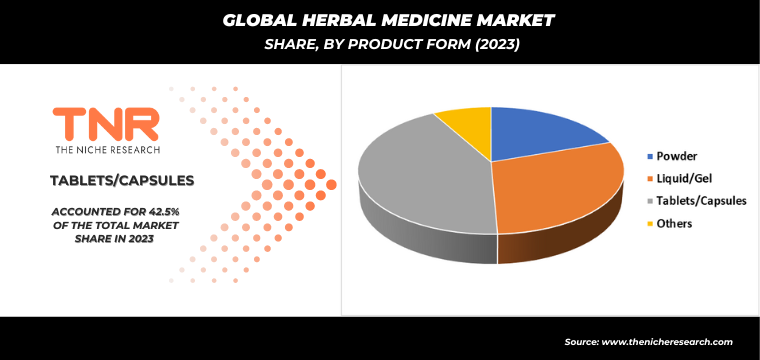
Root Segment has Garnered Major Market Share in the Global Herbal Medicine Market During the Forecast Period (2024 – 2034).
Roots are a cornerstone of herbal medicine, driving demand due to their potent therapeutic properties and historical significance. Many traditional remedies utilize roots like ginseng, turmeric, and ginger, known for their anti-inflammatory, immune-boosting, and digestive benefits. The growing consumer shift towards natural and holistic health solutions enhances the appeal of root-based treatments. Additionally, increasing scientific validation of these roots’ efficacy boosts consumer confidence and interest.
Roots are often integral to cultural and traditional practices, adding a layer of trust and familiarity for many users. The rising popularity of wellness trends and the clean label movement, which emphasizes natural ingredients, further fuels demand. Moreover, the versatility of roots in various forms—teas, supplements, tinctures, and powders—makes them accessible and convenient for diverse consumer needs. These factors collectively drive the robust demand for roots in the herbal medicine market.
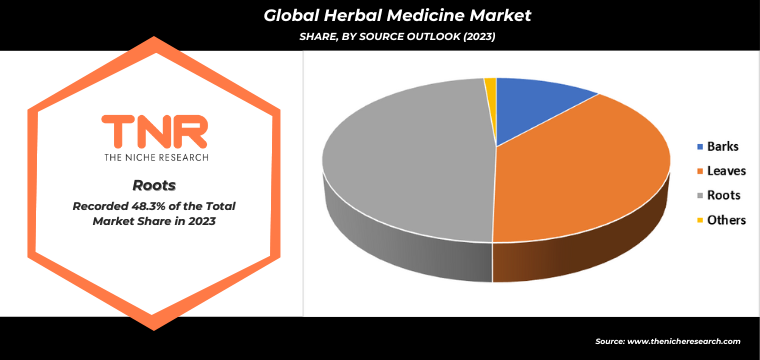
By Distribution Channel Direct Sales Segment had the Highest Share in the Global Herbal Medicine Market in 2023.
The direct sales model is a significant driver of demand for herbal medicine, leveraging personal connections and trust to boost consumer interest and adoption. Direct sales channels, including multi-level marketing (MLM) and network marketing, allow for personalized product recommendations and demonstrations, which are particularly effective for herbal remedies that benefit from detailed explanations and user testimonials. The growing consumer preference for natural health solutions amplifies this demand, as individuals seek personalized and trustworthy sources for herbal medicine.
Additionally, the flexibility and entrepreneurial opportunities offered by direct sales attract a diverse group of distributors passionate about health and wellness, further expanding market reach. The model also benefits from the increasing use of digital platforms, enabling direct sellers to reach a wider audience through online social networks and virtual consultations. These factors collectively enhance the visibility, credibility, and accessibility of herbal medicine through direct sales channels, driving robust market growth.
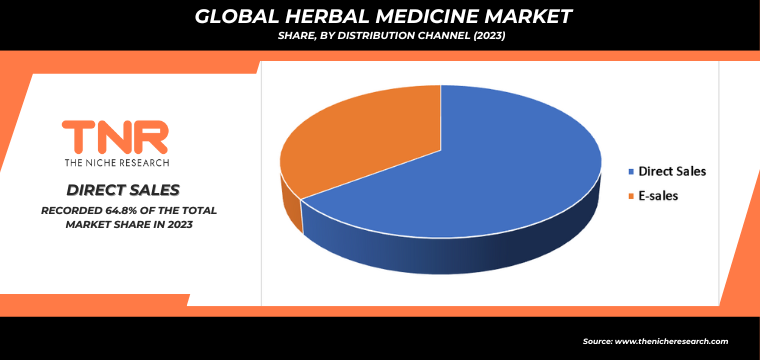
By Region, North America Dominated the Global Herbal Medicine Market in 2023.
The demand for herbal medicine in North America is significantly driven by a growing consumer preference for natural and holistic health solutions. Increasing awareness of the potential side effects associated with synthetic drugs is prompting many to turn to herbal alternatives for preventive and therapeutic purposes. The trend towards wellness and self-care, bolstered by the influence of social media and health influencers, is further boosting the popularity of herbal remedies.
Additionally, the aging population seeks gentler, more sustainable treatments for chronic conditions, enhancing the appeal of herbal medicine. The integration of herbal products into mainstream healthcare and the endorsement by medical professionals also play crucial roles in driving demand. Regulatory support and the availability of high-quality, scientifically validated herbal products in the market contribute to consumer confidence and adoption. Collectively, these factors are fostering robust growth in the herbal medicine market across North America.
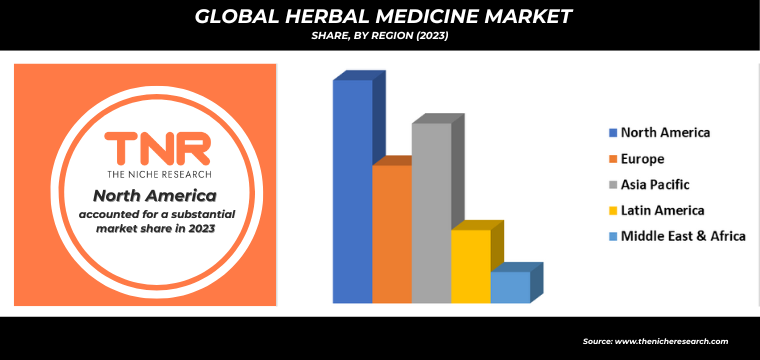
Competitive Landscape: Global Herbal Medicine Market:
- AYUSH Ayurvedic Pte Ltd.
- Bionorica SE
- Herb Pharm
- Herbal Hills
- International Chinese Body Care Houses
- KindCare Medical Center
- LKK Health Products Group Limited
- Ming Chen Clinic
- Nordic Nutraceuticals (now a part of Oy Verman Ab)
- Pascoe Natural Medicine
- Sheng Chang Pharmaceutical Company
- Sinomedica
- The Center for Natural and Integrative Medicine
- Other Industry Participants
Global Herbal Medicine Market Scope
| Report Specifications | Details |
| Market Revenue in 2023 | US$ 6.7 Bn |
| Market Size Forecast by 2034 | US$ 13.1 Bn |
| Growth Rate (CAGR) | 6.2% |
| Historic Data | 2016 – 2022 |
| Base Year for Estimation | 2023 |
| Forecast Period | 2024 – 2034 |
| Report Inclusions | Market Size & Estimates, Market Dynamics, Competitive Scenario, Trends, Growth Factors, Market Determinants, Key Investment Segmentation, Product/Service/Solutions Benchmarking |
| Segments Covered | By Product, By Surgery, By End User, By Region |
| Regions Covered | North America, Europe, Asia Pacific, Middle East & Africa, Latin America |
| Countries Covered | U.S., Canada, Mexico, Rest of North America, France, The UK, Spain, Germany, Italy, Nordic Countries (Denmark, Finland, Iceland, Sweden, Norway), Benelux Union (Belgium, The Netherlands, Luxembourg), Rest of Europe, China, Japan, India, New Zealand, Australia, South Korea, Southeast Asia (Indonesia, Thailand, Malaysia, Singapore, Rest of Southeast Asia), Rest of Asia Pacific, Saudi Arabia, UAE, Egypt, Kuwait, South Africa, Rest of Middle East & Africa, Brazil, Argentina, Rest of Latin America |
| Key Players | Ackermann Instrumente, B. Braun Melsungen AG, CONMED Corporation, EMED., Ethicon US, LLC., Integra LifeSciences, JINSHAN Science & Technology (Group) Co., Ltd., MEDGYN PRODUCTS, INC., Medtronic Plc., Miconvey SURGICAL, Olympus Corporation, Symmetry Surgical Inc. (Aspen Surgical), Telea Electronic Engineering S.r.l. |
| Customization Scope | Customization allows for the inclusion/modification of content pertaining to geographical regions, countries, and specific market segments. |
| Pricing & Procurement Options | Explore purchase options tailored to your specific research requirements |
| Contact Details | Consult With Our Expert
Japan (Toll-Free): +81 663-386-8111 South Korea (Toll-Free): +82-808- 703-126 Saudi Arabia (Toll-Free): +966 800-850-1643 United Kingdom: +44 753-710-5080 United States: +1 302-232-5106 E-mail: askanexpert@thenicheresearch.com
|
Global Herbal Medicine Market
By Medicinal Plant
- Marrubium Vulgare
- Vaccinium Macrocarpon
- Echinacea
- Curcuma Longa
- Camellia Sinensis
- Actaea Racemose
- Aloe Vera
- Zingiber Officinale
- Cocos Nucifera
- Cinnamomum Spp
- Allium Sativum
By Intervention
- Ayurveda
- Apitherapy
- Bach Flower Therapy
- Naturopathic Medicine
- Traditional Chinese Medicine
- Traditional Korean Medicine
- Traditional Japanese Medicine
- Traditional Mongolian Medicine
- Traditional Tibetan Medicine
- Zang Fu Theory
By Product Form
- Powder
- Liquid/Gel
- Tablets/Capsules
- Others
By Source Outlook
- Barks
- Leaves
- Roots
- Others
By Distribution Channel
- Direct Sales
- E-sales
By Application
- Pharmaceutical & Nutraceutical
- Food & Beverage
- Personal Care & Beauty Product
By Region
- North America (U.S., Canada, Mexico, Rest of North America)
- Europe (France, The UK, Spain, Germany, Italy, Nordic Countries (Denmark, Finland, Iceland, Sweden, Norway), Benelux Union (Belgium, The Netherlands, Luxembourg), Rest of Europe)
- Asia Pacific (China, Japan, India, New Zealand, Australia, South Korea, Southeast Asia (Indonesia, Thailand, Malaysia, Singapore, Rest of Southeast Asia), Rest of Asia Pacific)
- Middle East & Africa (Saudi Arabia, UAE, Egypt, Kuwait, South Africa, Rest of Middle East & Africa)
- Latin America (Brazil, Argentina, Rest of Latin America)
Report Layout:
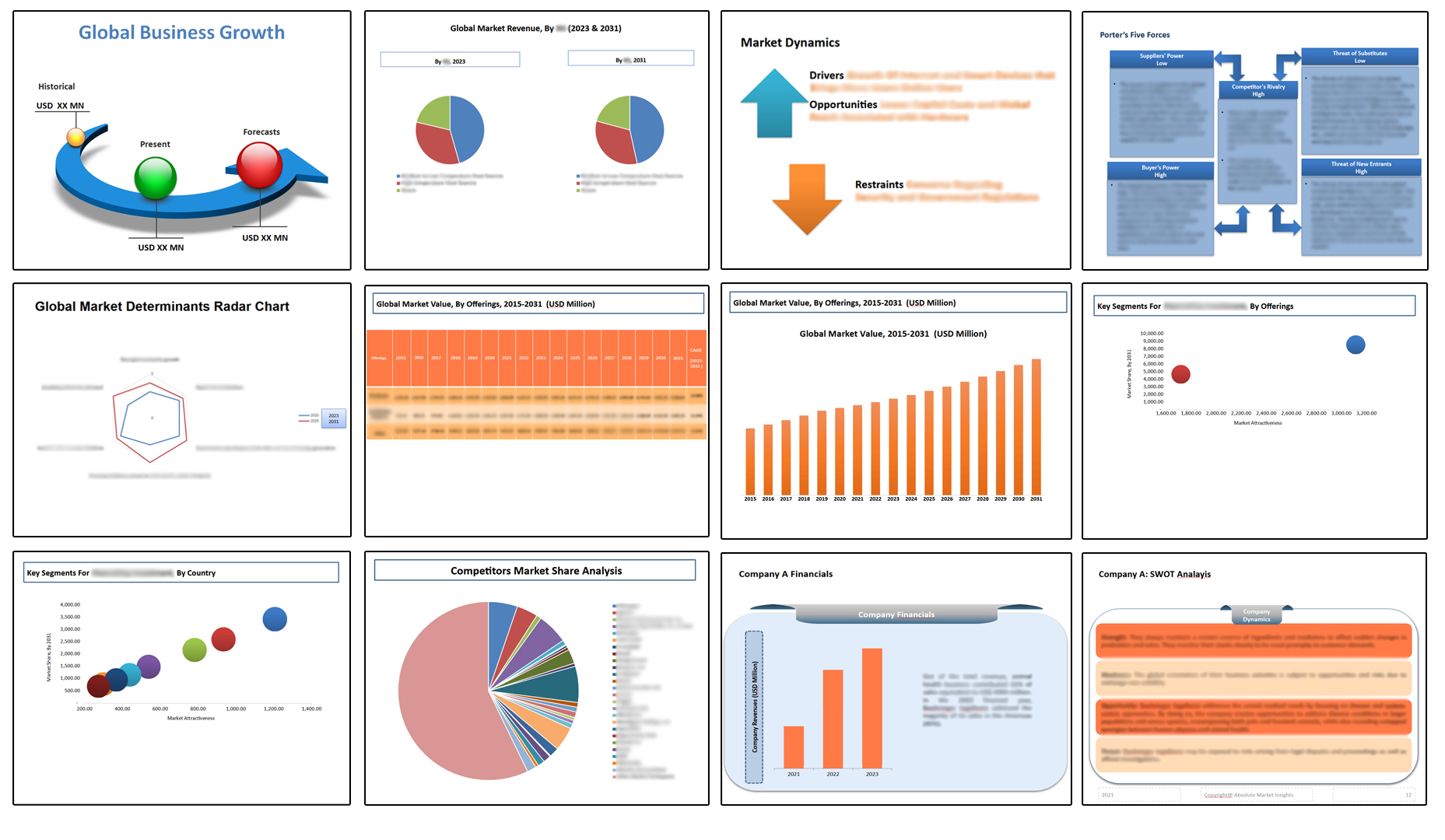
Table of Contents
Note: This ToC is tentative and can be changed according to the research study conducted during the course of report completion.
**Exclusive for Multi-User and Enterprise User.
Global Herbal Medicine Market
By Medicinal Plant
- Marrubium Vulgare
- Vaccinium Macrocarpon
- Echinacea
- Curcuma Longa
- Camellia Sinensis
- Actaea Racemose
- Aloe Vera
- Zingiber Officinale
- Cocos Nucifera
- Cinnamomum Spp
- Allium Sativum
By Intervention
- Ayurveda
- Apitherapy
- Bach Flower Therapy
- Naturopathic Medicine
- Traditional Chinese Medicine
- Traditional Korean Medicine
- Traditional Japanese Medicine
- Traditional Mongolian Medicine
- Traditional Tibetan Medicine
- Zang Fu Theory
By Product Form
- Powder
- Liquid/Gel
- Tablets/Capsules
- Others
By Source Outlook
- Barks
- Leaves
- Roots
- Others
By Distribution Channel
- Direct Sales
- E-sales
By Application
- Pharmaceutical & Nutraceutical
- Food & Beverage
- Personal Care & Beauty Product
By Region
- North America (U.S., Canada, Mexico, Rest of North America)
- Europe (France, The UK, Spain, Germany, Italy, Nordic Countries (Denmark, Finland, Iceland, Sweden, Norway), Benelux Union (Belgium, The Netherlands, Luxembourg), Rest of Europe)
- Asia Pacific (China, Japan, India, New Zealand, Australia, South Korea, Southeast Asia (Indonesia, Thailand, Malaysia, Singapore, Rest of Southeast Asia), Rest of Asia Pacific)
- Middle East & Africa (Saudi Arabia, UAE, Egypt, Kuwait, South Africa, Rest of Middle East & Africa)
- Latin America (Brazil, Argentina, Rest of Latin America)
The Niche Research approach encompasses both primary and secondary research methods to provide comprehensive insights. While primary research is the cornerstone of our studies, we also incorporate secondary research sources such as company annual reports, premium industry databases, press releases, industry journals, and white papers.
Within our primary research, we actively engage with various industry stakeholders, conducting paid interviews and surveys. Our meticulous analysis extends to every market participant in major countries, allowing us to thoroughly examine their portfolios, calculate market shares, and segment revenues.
Our data collection primarily focuses on individual countries within our research scope, enabling us to estimate regional market sizes. Typically, we employ a bottom-up approach, meticulously tracking trends in different countries. We analyze growth drivers, constraints, technological innovations, and opportunities for each country, ultimately arriving at regional figures.Our process begins by examining the growth prospects of each country. Building upon these insights, we project growth and trends for the entire region. Finally, we utilize our proprietary model to refine estimations and forecasts.
Our data validation standards are integral to ensuring the reliability and accuracy of our research findings. Here’s a breakdown of our data validation processes and the stakeholders we engage with during our primary research:
- Supply Side Analysis: We initiate a supply side analysis by directly contacting market participants, through telephonic interviews and questionnaires containing both open-ended and close-ended questions. We gather information on their portfolios, segment revenues, developments, and growth strategies.
- Demand Side Analysis: To gain insights into adoption trends and consumer preferences, we reach out to target customers and users (non-vendors). This information forms a vital part of the qualitative analysis section of our reports, covering market dynamics, adoption trends, consumer behavior, spending patterns, and other related aspects.
- Consultant Insights: We tap into the expertise of our partner consultants from around the world to obtain their unique viewpoints and perspectives. Their insights contribute to a well-rounded understanding of the markets under investigation.
- In-House Validation: To ensure data accuracy and reliability, we conduct cross-validation of data points and information through our in-house team of consultants and utilize advanced data modeling tools for thorough verification.
The forecasts we provide are based on a comprehensive assessment of various factors, including:
- Market Trends and Past Performance (Last Five Years): We accurately analyze market trends and performance data from preceding five years to identify historical patterns and understand the market’s evolution.
- Historical Performance and Growth of Market Participants: We assess the historical performance and growth trajectories of key market participants. This analysis provides insights into the competitive landscape and individual company strategies.
- Market Determinants Impact Analysis (Next Eight Years): We conduct a rigorous analysis of the factors that are projected to influence the market over the next eight years. This includes assessing both internal and external determinants that can shape market dynamics.
- Drivers and Challenges for the Forecast Period:Identify the factors expected to drive market growth during the forecast period, as well as the challenges that the industry may face. This analysis aids in deriving an accurate growth rate projection.
- New Acquisitions, Collaborations, or Partnerships: We keep a close watch on any new acquisitions, collaborations, or partnerships within the industry. These developments can have a significant impact on market dynamics and competitiveness.
- Macro and Micro Factors Analysis:A thorough examination of both macro-level factors (e.g., economic trends, regulatory changes) and micro-level factors (e.g., technological advancements, consumer preferences) that may influence the market during the forecast period.
- End-User Sentiment Analysis: To understand the market from the end-user perspective, we conduct sentiment analysis. This involves assessing the sentiment, preferences, and feedback of the end-users, which can provide valuable insights into market trends.
- Perspective of Primary Participants: Insights gathered directly from primary research participants play a crucial role in shaping our forecasts. Their perspectives and experiences provide valuable qualitative data.
- Year-on-Year Growth Trend: We utilize a year-on-year growth trend based on historical market growth and expected future trends. This helps in formulating our growth projections, aligning them with the market’s historical performance.
Research process adopted by TNR involves multiple stages, including data collection, validation, quality checks, and presentation. It’s crucial that the data and information we provide add value to your existing market understanding and expertise. We have also established partnerships with business consulting, research, and survey organizations across regions and globally to collaborate on regional analysis and data validation, ensuring the highest level of accuracy and reliability in our reports.









